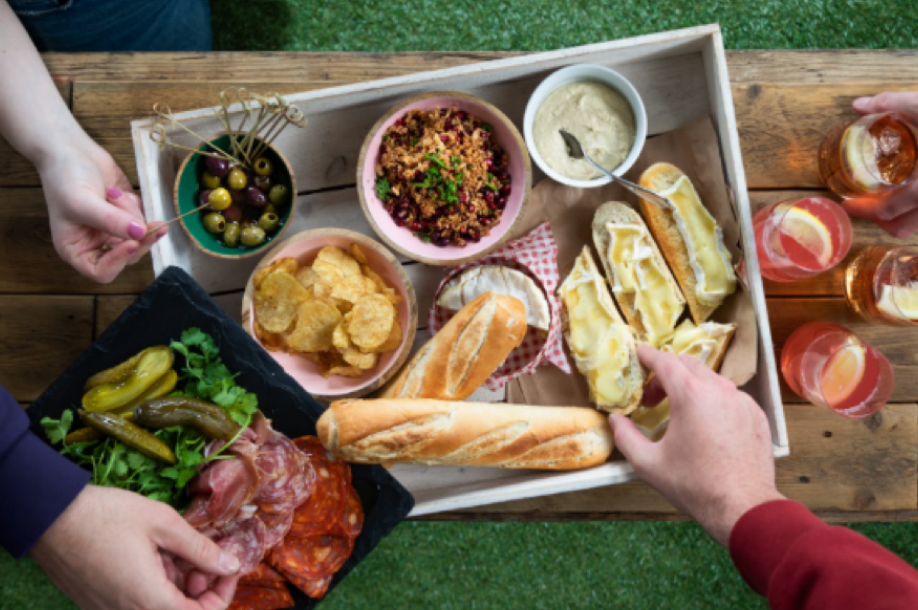Looking for the latest bakery trend must haves in 2026, Ross Lowrey- Heywood, Innovations Manager at Finsbury Food Group reveals the latest 2026 bakery trends.
What are the biggest bakery trends for 2026 and beyond?
2026 will see bakery trends evolve around three key pillars: flavour fusion, health-conscious indulgence and personalised formats.
We’re seeing rising demand for cakes and bakes that reflect more global inspiration and cross-category borrowing, think dessert-flavour hybrids like tiramisu s’mores, cookies stuffed with brownie or products with provenance, for example Amalfi lemon paired with white chocolate.
Snacking is the largest subsector of cakes and bread with ‘portionable’ formats and individual serves surging, not just for convenience, but for perceived health benefits. Consumers still want indulgence, but on their terms, creating small moments of joy.
We’re seeing a shift in occasions. Cakes are no longer just birthday-centred, there’s growth in ‘just because’ moments, thank-you gestures, enjoying a girls’ night in and personalised gifting. This opens up more space for storytelling and limited-edition launches within an emotive category.
In bread, sourdough is here to stay, and it has seen the biggest growth in the category (sitting at 46% YOY according to data from Nielsen) and enjoys cross-generational appeal. With its minimal ingredients and traditional fermentation process it’s the best performing bread in the market, despite being a premium choice. This highlights consumer willingness to pay more for perceived artisanal quality and health benefits, particularly amid growing awareness of ultra-processed foods. We are going to see sourdough increasingly popping up in different categories, with it already infiltrating pizza, crumpets, croissants and more – sourdough loaf cakes and sourdough cookies aren’t far away!
How are wider influences, such as macroeconomic factors, consumer shopping habits, or concerns around sustainability, impacting different parts of the bakery sector?
“With inflation high, the cost of ingredients to make cakes and bakes is forced to rise therefore increasing prices. Understandably, shoppers are putting value perception under the microscope. Consumers are still willing to treat themselves, but products need to work harder by offering multi-occasion relevance, clear portioning and emotional reward.
Sustainability is also reshaping innovation. There’s growing interest in how ingredients are sourced, how packaging impacts the planet and how brands communicate transparency. Retailers are putting more scrutiny on provenance and efficiency, so suppliers must be ready to demonstrate both.
Which ingredients or commodities will pose challenges in 2026? Why is this?
Butter, cocoa and eggs remain highly volatile commodities, particularly as extreme weather and geopolitical issues impact global supply chains. And of course, inflation has a direct impact on the cost of ingredients which poses challenges.
From a product development perspective, these constraints are driving smart reformulation and substitution strategies, without compromising taste or indulgence. That’s where strong technical teams and trusted supplier relationships are critical.
How will current, upcoming or potential legislation impact the baking industry?
Legislation around HFSS, Ultra-Processed Foods (UPF) and labelling transparency is already changing the way the baking industry innovates. At Finsbury, our approach balances consumer demand for variety and indulgence with a clear commitment to health, wellbeing and responsible enjoyment.
As a supplier with a broad portfolio of baked goods, we take pride in offering quality and choice that reflects both category expectations and shopper occasions. Innovation plays a central role here, whether through new ingredients, reformulation where appropriate or flavour development that keeps products exciting while remaining compliant.
We’ve introduced changes across multiple fronts, from developing smarter pack formats and appropriate portion sizing to dialling up seasonal relevance through limited-edition flavours that offer excitement without needing lots of promotion.
The bakery industry needs to continually evolve alongside the expectations of retailers and shoppers alike.
What is the greatest opportunity being presented to your bakery business in 2026 and why? How will you be taking advantage of it?The biggest opportunity lies in being able to deliver trend-led innovation at scale. With the size and scale of Finsbury, we’re in a strong position to respond quickly to new flavour profiles, shopper behaviours and tap into the zeitgeist, while being able to bring this to market through major brand collaborations or seasonal launches thanks to our portfolio of licensed brands. We’re especially excited about new launches that play into cultural moments, emerging formats and category-crossing creativity.
Snacking is a huge area of growth when it comes to buns, rolls and cakes, especially for on-the-go convenience and for health-conscious individuals. And of course, expanding and improving gluten free products is a big focus too.
With so many people working from home for at least a portion of their week, breakfast and lunch habits have evolved. Consumers now have more time to prepare food at home, increasing demand for more premium and artisanal everyday items. Sourdough toast topped with avocado, eggs or nut butters has become synonymous with this ‘better at home’ lifestyle.
What flavours, formats, and occasions will be big in bakery in 2026?
Bakery is entering a bold, playful era. Hybrid formats like cruffins, brookies and reimagined donuts continue to blur category lines and capture consumer imagination. We’re also seeing a shift towards multi-layered bakes that deliver on both texture and flavour: think crunch, creaminess and softness all in one bite, creating an elevated sensory experience. Stuffed formats are thriving too, with cookies, muffins and cakes increasingly filled with indulgent centres, from caramel to Biscoff.
Formats that deliver personalisation, shareability and visual appeal will continue to grow, such as mini formats and letterbox cakes.
Flavour-wise, we’re seeing strong growth in nostalgic comfort with a twist, things like red velvet or carrot cake paired with a mascarpone frosting instead of cream cheese or tropical additions like mango folded into batter. We’re also seeing a rise in elevated global flavours, particularly pan-Asian flavours like yuzu and black sesame and novel fusions such as hot honey or miso caramel.
In bread, sourdough still has room to rise, particularly in flavoured and functional variants. While the base recipe remains rooted in tradition, brands and retailers are experimenting with new inclusions such as cheddar, sun-dried tomato and olives. It doesn’t have to be savoury, for example chocolate orange sourdough and blueberry and lemon sourdough have also come onto the scene and been welcomed by consumers with open arms. Just because sourdough is a bread, it doesn’t have to be eaten as a savoury choice, with people opting to drizzle it with hot honey and figs, meaning it’s an incredibly versatile choice which shoppers love.
As we’ve already touched on, we are going to see sourdough crossing categories into the bakery aisle with the likes of sourdough loaf cakes and sourdough cookies.
Occasions are expanding. We’re not just catering to birthdays and holidays anymore, it’s about small wins, self-gifting and celebration of everyday moments. People are looking for ways to elevate everyday moments, with snacking providing a moment of joy during the day or something to enjoy while on the go.
How is technology, including AI, influencing the way baked goods are produced?
On the production side, smart automation is helping drive consistency, reduce waste and support scale which is especially important when balancing a broad portfolio of licensed and own-brand ranges across bakery.
How are the UPF and clean label conversations evolving, and what impact is this having on the sector?
Awareness of Ultra-Processed Foods is growing, and transparency matters as shoppers want to know what’s in their food and why. They want to see store cupboard ingredients that they recognise in the list of ingredients, and if there’s something they aren’t familiar with, there needs to be a clear functional benefit for its inclusion, such as prolonged shelf life.
Across the sector, this means a move to simplifying ingredients lists, avoiding unnecessary additives and being proactive in educating consumers, all while ensuring taste, texture and shelf life aren’t compromised.
And of course, there are winners and losers when it comes to UPF, with sourdough benefitting as consumers become more attracted to a product with only three ingredients that represents artisanal quality.
How are consumer needs evolving? How does this differ across different generations?
“Younger shoppers are digitally driven, flavour-curious and planet-conscious. They’re open to new formats and global inspiration but want transparency and traceability. Older generations still value familiarity and quality but we’re seeing increased appetite for personalisation and premiumisation even here.
The big constant across all generations is emotional connection. Whether it’s nostalgia, indulgence or celebration, bakery plays a role and brands that understand that will flourish.
What impact is social media, such as TikTok, having on the bakery market and consumers’ perception and expectation of it?
Social platforms, especially TikTok and Instagram, are shaping expectation, not just discovery. Consumers now expect cakes and bakes to be visually striking, ‘share-worthy’ and emotionally resonant.
This is fuelling the rise of interactive formats, personalised decoration and limited-edition products that tap into seasonal trends. It’s also impacting flavour profiles with viral combinations often crossing categories quickly, for example the boom in matcha and pistachio we’ve seen this year.
While trending products tend to fly off the shelves, their success can be short lived, similar to the lifespan of a viral social media moment so it’s not a strategy for long term success. Innovation needs to be both reactive and thoughtful and not trend-chasing for the sake of it.
What part do different channels – delivery, click & collect, bricks & mortar, etc have to play in the bakery market in the future?
We’re always exploring new opportunities and channels at Finsbury. We actively track emerging trends and consumer behaviours to understand how purchasing habits are evolving, and we continuously adapt our approach in response.
More generally, convenience and immediacy are the real winners with shoppers making faster, more frequent top-up shops with a mix of online and in-store. Click & collect, third-party delivery and bakery counters in foodservice-led retailers are all growing. For brands, that means developing versatile formats that travel well, look great on the shelf and offer excitement in smaller footprints.



